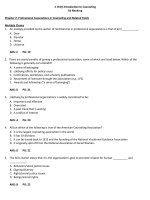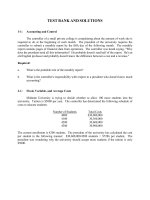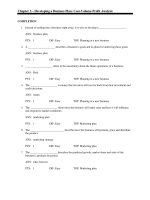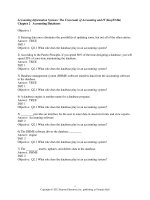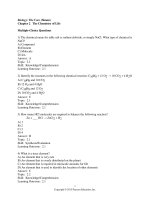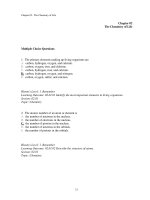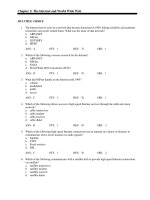Financial accounting making the connection 1st edition spiceland test bank
Bạn đang xem bản rút gọn của tài liệu. Xem và tải ngay bản đầy đủ của tài liệu tại đây (612.99 KB, 122 trang )
Chapter 02 - The Accounting Information System
Chapter 02
The Accounting Information System
Multiple Choice Questions
1. Which of the following is not part of measuring external transactions?
A. Using source documents to analyze accounts affected.
B. Recording transactions.
C. Making payments on all amounts owed.
D. Analyzing transactions for their effect on the accounting equation.
2. External events include all of the following except:
A. Paying employees' salaries.
B. Purchasing equipment.
C. Using office supplies.
D. Collecting an account receivable.
3. Which step in the process of measuring external transactions involves assessing the
equality of total debits and total credits?
A. Use source documents to determine accounts affected by the transaction.
B. Prepare a trial balance.
C. Analyze the impact of the transaction on the accounting equation.
D. Post the transaction to the T-account in the general ledger.
4. For each transaction recorded in an accounting system, the basic equation that must be
maintained at all times is:
A. Assets = Liabilities + Stockholders' Equity.
B. Cash Increases = Cash Decreases.
C. Revenues = Expenses + Dividends.
D. Assets = Liabilities.
2-1
Chapter 02 - The Accounting Information System
5. The following amounts are reported in the ledger of Mariah Company:
What is the balance in the Common Stock account?
A. $44,000.
B. $32,000.
C. $48,000.
D. $42,000.
6. When a company incurs workers' salaries but does not pay them, how will the basic
accounting equation be affected?
A. Stockholders' equity decreases.
B. Revenues decrease.
C. Expenses decrease.
D. Liabilities decrease.
7. When cash payments are made to stockholders, what is the effect on the company's
accounts?
A. Cash decreases and dividends increase.
B. Cash increases and dividends decrease.
C. Cash decreases and common stock decreases.
D. Cash increases and common stock increases.
8. Which of the following is not an asset account?
A. Supplies.
B. Accounts Payable.
C. Equipment.
D. Accounts Receivable.
2-2
Chapter 02 - The Accounting Information System
9. An account receivable can best be defined as:
A. A payment to the owners.
B. A sale of goods and services.
C. A resource owned by the company.
D. An amount owed by the company.
10. Receiving assets from customers before services are performed results in:
A. Prepaid Assets.
B. Service Revenue.
C. Unearned Revenues.
D. Accounts Receivable.
11. When the company pays stockholders a dividend, what is the effect on the accounting
equation for that company?
A. Decrease stockholders' equity and increase assets.
B. Increase liabilities and increase assets.
C. Decrease assets and decrease liabilities.
D. Decrease assets and decrease stockholders' equity.
12. Pumpkin Inc. sold $500 in pumpkins to a customer on account on January 1. On January
11 Pumpkin collected the cash from that customer. What is the impact on Pumpkin's
accounting equation from the collection of cash?
A. No net effect to the accounting equation.
B. Decrease assets and increase liabilities.
C. Increase assets and increase liabilities.
D. Decrease assets and decrease liabilities.
13. A company receives a $50,000 cash deposit from a customer on October 15 but will not
provide services until November 20. Which of the following statements is true?
A. The company records service revenue on October 15.
B. The company records cash collection November 20.
C. The company records an unearned revenue on October 15.
D. The company records nothing on October 15.
2-3
Chapter 02 - The Accounting Information System
14. Which of the following would increase assets and increase liabilities?
A. Provide services to customers on account.
B. Purchase office supplies on account.
C. Pay dividends to stockholders.
D. Received a utility bill but do not pay for it.
15. Receiving cash from an account receivable:
A. Increases a revenue and decreases an asset.
B. Decreases a liability and increases an asset.
C. Increases an asset and increases a revenue.
D. Increases one asset and decreases another asset.
16. An expense has what effect on the accounting equation?
A. Decrease liabilities.
B. Decrease stockholders' equity.
C. Increase assets.
D. No effect.
17. A revenue has what effect on the accounting equation?
A. Increase liabilities.
B. Decrease assets.
C. Increase stockholders' equity.
D. No effect.
18. Investments by stockholders have what effect on the accounting equation?
A. Assets increase and liabilities increase.
B. Expenses increase and liabilities increase.
C. Assets increase and revenues increase.
D. Assets increase and stockholders' equity increases.
2-4
Chapter 02 - The Accounting Information System
19. Which of the following is not possible when recording a transaction?
A. Liabilities increase and assets decrease.
B. Stockholders' equity increases and assets increase.
C. One asset increases and another asset decreases.
D. Stockholders' equity decreases and assets decrease.
20. Amounts owed to suppliers for supplies purchased on account are defined as:
A. Cash.
B. Accounts Receivable.
C. Accounts Payable.
D. Supplies Expense.
21. Purchasing office supplies on account will:
A. Not change assets.
B. Increase assets and decrease liabilities.
C. Increase assets and increase liabilities.
D. Increase assets and increase stockholders' equity.
22. Providing services and receiving cash will:
A. Increase assets and increase stockholders' equity.
B. Increase assets and increase liabilities.
C. Decrease assets and increase liabilities.
D. Decrease liabilities and increase stockholders' equity.
23. When a company provides services on account, the accounting equation would be affected
as follows:
A. Assets increase.
B. Revenues increase.
C. Assets increase and liabilities decrease.
D. Assets increase and stockholders' equity increases.
2-5
Chapter 02 - The Accounting Information System
24. If a company provides services on account, which of the following is true?
A. Expenses increase.
B. Liabilities increase.
C. Stockholders' equity increases.
D. Assets decrease.
25. When a payment is made on an account payable:
A. Assets and stockholders' equity decrease.
B. Assets and liabilities decrease.
C. Liabilities and revenues decrease.
D. Assets and expenses decrease.
26. Purchasing office equipment on account has what impact on the accounting equation?
A. Stockholders' equity decreases and assets increase.
B. Liabilities increase and assets increase.
C. Assets decrease and liabilities decrease.
D. Assets increase and stockholders' equity increases.
27. Purchasing supplies for cash has what effect on the accounting equation?
A. Increase assets.
B. Decrease stockholders' equity.
C. Decrease liabilities.
D. No effect.
28. The Unearned Revenue account is shown in which statement?
A. Income statement.
B. Statement of cash flows.
C. Balance sheet.
D. Statement of stockholders' equity.
2-6
Chapter 02 - The Accounting Information System
29. On January 1, Brad Inc. sold $30,000 in products to a customer on account. Then, on
January 10, Brad collected the cash on that account. What is the impact on Brad's accounting
equation from the collection of cash on January 10?
A. No net effect to the accounting equation.
B. Assets increase and liabilities decrease.
C. Assets decrease and liabilities decrease.
D. Assets increase and stockholders' equity increases.
30. Consider the following transactions:
Issued common stock for cash.
Purchased equipment by signing a note payable.
Provided services to customers on account.
Collected cash from customers on account.
How many of these four transactions increased the given company's total liabilities?
A. One.
B. Two.
C. Three.
D. Four.
31. Consider the following transactions:
Issued common stock for cash.
Purchased equipment by signing a note payable.
Paid rent for the current month.
Collected cash from customers on account.
How many of these four transactions increased the given company's total assets?
A. One.
B. Two.
C. Three.
D. Four.
2-7
Chapter 02 - The Accounting Information System
32. Assume that Sallisaw Sideboards, Inc. had a retained earnings balance of $10,000 on
April 1, and that the company had the following transactions during April.
Issued common stock for cash, $5,000.
Provided services to customers on account, $2,000.
Provided services to customers in exchange for cash, $900.
Purchased equipment and paid cash, $4,300.
Paid April rent, $800.
Paid workers salaries for April, $700.
What was Sallisaw's retained earnings balance at the end of April?
A. $11,400.
B. $12,100.
C. $16,400.
D. Some other amount.
33. Following are transactions of Gotebo Tanners, Inc., a new company, during the month of
January 2012:
1. Issued 10,000 shares of common stock for $15,000 cash.
2. Purchased land for $12,000, signing a note payable for the full amount.
3. Purchased office equipment for $1,200 cash.
4. Received cash of $14,000 for services provided to customers during the month.
5. Purchased $300 of office supplies on account.
6. Paid employees $10,000 for their first month's salaries.
What was the balance of Gotebo's Cash account following these six transactions?
A. $29,800.
B. $19,300.
C. $17,800.
D. $22,400.
2-8
Chapter 02 - The Accounting Information System
34. Following are transactions of Gotebo Tanners, Inc., a new company, during the month of
January 2012:
1. Issued 10,000 shares of common stock for $15,000 cash.
2. Purchased land for $12,000, signing a note payable for the full amount.
3. Purchased office equipment for $1,200 cash.
4. Received cash of $14,000 for services provided to customers during the month.
5. Purchased $300 of office supplies on account.
6. Paid employees $10,000 for their first month's salaries.
What was the total amount of Gotebo's liabilities following these six transactions?
A. $12,300.
B. $27,300.
C. $22,600.
D. $15,500.
35. Following are transactions of Gotebo Tanners, Inc., a new company, during the month of
January 2012:
1. Issued 10,000 shares of common stock for $15,000 cash.
2. Purchased land for $12,000, signing a note payable for the full amount.
3. Purchased office equipment for $1,200 cash.
4. Received cash of $14,000 for services provided to customers during the month.
5. Purchased $300 of office supplies on account.
6. Paid employees $10,000 for their first month's salaries.
How many of these transactions decreased Gotebo's total assets?
A. One.
B. Two.
C. Three.
D. Four.
2-9
Chapter 02 - The Accounting Information System
36. Following are transactions of Gotebo Tanners, Inc., a new company, during the month of
January 2012:
1. Issued 10,000 shares of common stock for $15,000 cash.
2. Purchased land for $12,000, signing a note payable for the full amount.
3. Purchased office equipment for $1,200 cash.
4. Received cash of $14,000 for services provided to customers during the month.
5. Purchased $300 of office supplies on account.
6. Paid employees $10,000 for their first month's salaries.
How many of these transactions increased Gotebo's liabilities?
A. Four.
B. Three.
C. Two.
D. One.
37. Which of the following transactions causes a decrease in stockholders' equity?
A. Pay dividends to stockholders.
B. Obtain cash by borrowing from a local bank.
C. Provide services to customers on account.
D. Purchase office equipment for cash.
38. How many of the following events would require an expense to be recorded?
Ordering office supplies
Hiring a receptionist
Paying employee salaries for the current month
Receiving but not paying a current utility bill
Paying for insurance in advance
A. One.
B. Two.
C. Three.
D. Four.
2-10
Chapter 02 - The Accounting Information System
39. On September 30, MFP Co. paid employee salaries $7,000, including $1,000 it owed to its
employees last month. What are the effects of this transaction on the accounting equation?
A. Expenses increased, liabilities increased, and assets increased.
B. Assets decreased, liabilities decreased, and expenses increased.
C. Assets decreased, expenses decreased, and liabilities increased.
D. Expenses decreased, liabilities decreased, and assets decreased.
E. Assets increased, expenses increased, and liabilities decreased.
40. Which of the following is NOT possible for a business transaction?
A. Increase assets and decrease revenue.
B. Decrease assets and increase expense.
C. Increase liabilities and increase expense.
D. Decrease liabilities and increase revenue.
41. Which of the following transactions would cause a decrease in both assets and
stockholders' equity?
A. Paying insurance premium for the next two years.
B. Purchasing office equipment on account.
C. Paying advertising for the current month.
D. Providing installation services to customers.
42. When a company issues common stock for cash, what is the effect on the accounting
equation for the company?
A. Assets increase and liabilities increase.
B. Assets increase and stockholders' equity increases.
C. Assets decrease and liabilities decrease.
D. Liabilities decrease and stockholders' equity increases.
43. Which of the following is possible for a particular business transaction?
A. Increase assets; Decrease liabilities
B. Decrease assets; Increase assets
C. Decrease assets; Increase stockholders' equity
D. Decrease liabilities; Increase expenses
2-11
Chapter 02 - The Accounting Information System
44. Providing services to customers on account would affect the balances reported in which
financial statement(s)?
A. Income statement
B. Statement of stockholders' equity
C. Balance sheet
D. All of the financial statements would be affected
45. If the liabilities of a company increased by $55,000 during a month and the stockholders'
equity decreased by $21,000 during that same month, did assets increase or decrease and by
how much?
A. $34,000 increase
B. $55,000 increase
C. $34,000 decrease
D. $76,000 increase
46. Which of the accounts are decreased on the debit side and increased on the credit side?
A. Liabilities, stockholders' equity, and revenues.
B. Dividends, liabilities, and assets.
C. Expenses, dividends, and stockholders' equity.
D. Assets, dividends, and expenses.
47. Which of the following is/are true about a "debit"?
I. It is part of the double-entry procedure that keeps the accounting equation in balance.
II. It represents an increase to assets.
III. It represents a decrease to liabilities.
IV. It is on the right side of a T-account.
A. I and II.
B. IV only.
C. I, II, and III.
D. I, II, III, and IV.
2-12
Chapter 02 - The Accounting Information System
48. Which of the following is/are true about a "credit"?
I. It is part of the double-entry procedure that keeps the accounting equation in balance.
II. It represents a decrease to assets.
III. It represents an increase to liabilities.
IV. It is on the right side of a T-account.
A. I and II.
B. IV only.
C. I, II, and III.
D. I, II, III, and IV.
49. Dividends normally carry a _______ balance and are shown in the _________.
A. Debit; Statement of stockholders' equity
B. Debit; Income statement
C. Credit; Balance sheet
D. Debit; Balance Sheet
50. Expenses normally carry a _______ balance and are shown in the _________.
A. Debit; Statement of stockholders' equity
B. Debit; Income statement
C. Credit; Balance sheet
D. Debit; Balance Sheet
51. Liabilities normally carry a _______ balance and are shown in the _________.
A. Debit; Statement of stockholders' equity
B. Debit; Income statement
C. Credit; Balance sheet
D. Debit; Balance Sheet
2-13
Chapter 02 - The Accounting Information System
52. Which of the following accounts has a debit balance?
A. Accounts Payable.
B. Unearned Revenue.
C. Service Revenue.
D. Salaries Expense.
53. Which of the following accounts would normally have a credit balance?
A. Accounts Payable, Service Revenue, Common Stock.
B. Salaries Payable, Unearned Revenue, Delivery Expense.
C. Income Tax Payable, Service Revenue, Dividends.
D. Cash, Repairs and Maintenance Expense, Dividends.
54. Which of the following accounts would normally have a debit balance?
A. Accounts Payable, Service Revenue, Common Stock.
B. Salaries Payable, Unearned Revenue, Utilities Expense.
C. Income Tax Payable, Service Revenue, Dividends.
D. Cash, Delivery expense, Dividends.
55. Which of the following accounts would normally have a debit balance and appear in the
balance sheet?
A. Accounts Receivable.
B. Unearned Revenue.
C. Salaries Expense.
D. Dividends.
56. Which of the following accounts has a credit balance?
A. Salaries Expense.
B. Income Tax Payable.
C. Land.
D. Prepaid Rent.
2-14
Chapter 02 - The Accounting Information System
57. Which of the accounts are increased with a debit and decreased with a credit?
A. Liabilities, stockholders' equity, and revenues.
B. Dividends, liabilities, and assets.
C. Expenses, dividends, and stockholders' equity.
D. Assets, dividends, and expenses.
58. Consider the following list of accounts:
How many of these accounts have a normal debit balance?
A. Four.
B. Five.
C. Six.
D. Seven.
59. Consider the following list of accounts:
Accounts Payable
Cash
Prepaid Rent
Common Stock
Salaries Payable
Equipment
Supplies
Rent Expense
How many of these accounts have a normal credit balance?
A. Two.
B. Three.
C. Four.
D. Five.
2-15
Chapter 02 - The Accounting Information System
60. Consider the following accounts:
Utilities Expense
Accounts Payable
Service Revenue
Common Stock
How many of these accounts are increased with debits?
A. One.
B. Two.
C. Three.
D. Four.
61. Consider the following accounts:
Dividends
Insurance Expense
Cash
Service Revenue
How many of these accounts are increased with credits?
A. One.
B. Two.
C. Three.
D. Four.
62. Which one of the following accounts will have a credit balance?
A. Dividends
B. Salary Expense
C. Supplies
D. Common Stock
2-16
Chapter 02 - The Accounting Information System
63. The following statements pertain to recording transactions. Which of them are true?
I. Total debits should equal total credits.
II. It is possible to have multiple debits or credits in one journal entry.
III. Assets are always listed first in journal entries.
IV. Some journal entries will have debits only.
A. I only.
B. I and II.
C. I, II, and IV.
D. II, III, and IV.
64. Which of the following is not a possible journal entry?
A. Credit assets; Debit expenses.
B. Debit assets; Debit stockholders' equity.
C. Credit revenues; Debit assets.
D. Debit expenses; Credit liabilities.
65. Providing services on account would be recorded with a:
A. Debit to Service Revenue.
B. Credit to Accounts Receivable.
C. Credit to Accounts Payable.
D. Debit to Accounts Receivable.
66. Xenon Corporation borrows $75,000 from First Bank. Xenon Corporation records this
transaction with a:
A. Debit to Investments.
B. Credit to Retained Earnings.
C. Credit to Notes Payable.
D. Credit to Interest Expense.
2-17
Chapter 02 - The Accounting Information System
67. Childers Service Company provides services to customers totaling $3,000, for which it
billed the customers. How would the transaction be recorded?
A. Debit Cash $3,000, credit Service Revenue $3,000.
B. Debit Accounts Receivable $3,000, credit Service Revenue $3,000.
C. Debit Accounts Receivable $3,000, credit Cash $3,000.
D. Debit Service Revenue $3,000, credit Accounts Receivable $3,000.
68. A company received a bill for newspaper advertising services received, $400. The bill will
be paid in 10 days. How would the transaction be recorded today?
A. Debit Advertising Expense $400, credit Accounts Payable $400.
B. Debit Accounts Payable $400, credit Advertising Expense $400.
C. Debit Accounts Payable $400, credit Cash $400.
D. Debit Advertising Expense $400, credit Cash $400.
69. When a company pays utilities of $1,800 in cash, the transaction is recorded as:
A. Debit Utilities Expense $1,800, credit Utilities Payable $1,800.
B. Debit Utilities Payable $1,800, credit Cash $1,800.
C. Debit Cash $1,800, credit Utilities Expense $1,800.
D. Debit Utilities Expense $1,800, credit Cash $1,800.
70. Assume that cash is paid for rent to cover the next year. The appropriate debit and credit
are:
A. Debit Rent Expense, credit Cash.
B. Debit Prepaid Rent, credit Rent Expense.
C. Debit Prepaid Rent, credit Cash.
D. Debit Cash, credit Prepaid Rent.
71. Summer Leasing received $12,000 for 24 months rent in advance. How should Summer
record this transaction?
A. Debit Prepaid Rent; credit Rent Expense.
B. Debit Cash; credit Unearned Revenue.
C. Debit Cash; credit Service Revenue.
D. Debit Rent Expense; credit Cash.
2-18
Chapter 02 - The Accounting Information System
72. Styleson Inc. performed cleaning services for its customers for cash. These transactions
would be recorded as:
A. Debit Service Revenue, credit Cash.
B. Debit Cash, credit Service Revenue.
C. Debit Cash, credit Accounts Receivable.
D. Debit Accounts Receivable, credit Service Revenue.
73. Assume that $18,000 cash is paid for insurance to cover the next year. The appropriate
debit and credit are:
A. Debit Insurance Expense $18,000, credit Prepaid Insurance $18,000.
B. Debit Prepaid Insurance $18,000, credit Insurance Expense $18,000.
C. Debit Prepaid Insurance $18,000, credit Cash $18,000.
D. Debit Cash $18,000, credit Prepaid Insurance $18,000.
74. Schooner Inc. purchased equipment by signing a note payable. This transaction would be
recorded as:
A. Debit Equipment, credit Cash.
B. Debit Cash, credit Notes Payable.
C. Debit Notes Payable, credit Equipment.
D. Debit Equipment, credit Notes Payable.
75. When a company pays $2,500 dividends to its stockholders, the transaction should be
recorded as:
A. Debit Cash; credit Dividends.
B. Debit Retained Earnings; credit Dividends.
C. Debit Dividends; credit Cash.
D. Debit Dividends; credit Accounts Payable.
76. Daniel Dino Restaurant owes workers' salaries of $15,000. This would be recorded as:
A. Debit Salaries Expense, credit Cash.
B. Debit Salaries Payable, credit Cash.
C. Debit Salaries Expense, credit Salaries Payable.
D. Debit Salaries Payable, credit Salaries Expense.
2-19
Chapter 02 - The Accounting Information System
77. Jerome purchased a building for his business by signing a note to pay the amount due over
the next ten years. Which of the following correctly describes how to record this transaction?
A. Debit assets, credit liabilities.
B. Debit assets, credit stockholders' equity.
C. Debit liabilities, credit assets.
D. Debit expenses, credit liabilities.
78. Incurring an expense for advertising on account would be recorded by:
A. Debiting liabilities.
B. Crediting assets.
C. Debiting an expense.
D. Debiting assets.
79. Tyler Incorporated receives $150,000 from investors for issuing them shares of its
common stock. Tyler Incorporated records this transaction with a:
A. Debit to Investments.
B. Credit to Retained Earnings.
C. Credit to Common Stock.
D. Credit to Service Revenue.
80. The owner of an office building should report rent collected in advance as a debit to Cash
and a credit to:
A. A liability.
B. An asset other than Cash.
C. A revenue.
D. An owners' equity.
81. Clement Company paid an account payable related to a previous utility bill of $1,000.
This transaction should be recorded as follows on the payment date:
A. Debit Accounts Payable $1,000, credit Cash $1,000.
B. Debit Cash $1,000, credit Accounts Payable $1,000.
C. Debit Utilities Expense $1,000, credit Cash $1,000.
D. Debit Cash $1,000, credit Utilities Expense $1,000.
2-20
Chapter 02 - The Accounting Information System
82. On July 7, 2012, Saints Inc. received $10,000 in cash from a customer for services to be
provided on October 10, 2012. Which of the following describes how the transaction should
be recorded on July 7, 2012?
A. Debit Cash $10,000, credit Service Revenue $10,000.
B. Debit Accounts Receivable $10,000, credit Service Revenue $10,000.
C. Debit Cash $10,000, credit Unearned Revenue $10,000.
D. Debit Unearned Revenue $10,000, credit Cash $10,000.
83. On December 1, 2012, Bears Inc. signed a contract with a retailer to supply maintenance
for the next calendar year. How should this transaction be recorded on December 1, 2012?
A. Debit Cash, credit Service Revenue.
B. Debit Cash, credit Accounts Receivable.
C. Debit Accounts Receivable, credit Service Revenue.
D. No transaction should be recorded on December 1, 2012.
84. On July 31, ALOE Inc. received $5,000 cash from a customer who previously purchased
ALOE's products on account. What should ALOE Inc. record at the time it receives cash?
A. Debit Accounts Receivable, $5,000; credit Cash, $5,000.
B. Debit Cash, $5,000; credit Accounts Receivable, $5,000.
C. Debit Cash, $5,000; credit Accounts Payable, $5,000.
D. Debit Cash, $5,000; credit Service Revenue, $5,000.
85. Tomlin & Company provides music for special occasions. On January 14, the Smith
family hired Tomlin for an upcoming family wedding for an agreed upon fee of $10,000. The
wedding was scheduled for May 23. As part of the agreement, the Smiths paid Tomlin half of
the fee at the end of April with the remaining amount due by the end of June. How would
Tomlin record the receipt of the final payment in June?
A. Credit to Accounts Receivable.
B. Credit to Service Revenue.
C. Credit to Cash.
D. Debit to Unearned Revenue.
2-21
Chapter 02 - The Accounting Information System
86. Bostel wanted to expand the size of its warehouse in order to generate more profits. The
company decided to purchase the building adjacent to its existing warehouse. The company
pays for the building by borrowing from the bank. The purchase would be recorded as:
A. Debit Cash; credit Notes Payable.
B. Debit Buildings; credit Cash.
C. Debit Buildings; Credit Notes Payable.
D. Debit Cash and Buildings; Credit Notes Payable.
87. On July 5, Harris Company purchased supplies from the hardware store for $600 on
account. On July 10, Harris receives a bill from the hardware store as a reminder about the
account balance. On July 17, Harris pays the account in full. How does Harris record the
transaction on July 17?
A.
B.
C.
D.
88. The Accounts Payable account has a beginning balance of $12,000 and the company
purchased $50,000 of supplies on account during the month. The ending balance was $10,000.
How much did the company pay to creditors during the month?
A. $50,000.
B. $52,000.
C. $60,000.
D. $62,000.
2-22
Chapter 02 - The Accounting Information System
89. On March 3, Cobra Inc. purchased a desk for $450 on account. On March 22, Cobra
purchased another desk for $500 also on account, and then on March 24, Cobra paid $400 on
account. At the end of March, what amount should Cobra report for desks (assuming these
two desks were the only desks they had)?
A. $50.
B. $450.
C. $500.
D. $950.
90. Posting is the process of:
A. Analyzing the impact of the transaction on the accounting equation.
B. Obtaining information about external transactions from source documents.
C. Transferring the debit and credit information from the journal to individual accounts in the
general ledger.
D. Listing all accounts and their balances at a particular date.
91. Accounts Receivable account has a beginning balance of $10,000 and the company
provides services of $50,000 on account during the month. The ending balance was $12,000.
How much did the company receive from customers during the month?
A. $50,000.
B. $52,000.
C. $48,000.
D. $62,000.
92. Posting transactions to the T-accounts involve:
A. Analyzing source documents to determine the effects of transactions on the company's
accounts.
B. Listing all accounts and their balances at a particular date to ensure that debits equal
credits.
C. Preparing a chronological record of all transactions affecting the company.
D. Transferring debit and credit information from the journal to the accounts in the general
ledger.
2-23
Chapter 02 - The Accounting Information System
93. A trial balance can best be explained as a list of:
A. The income statement accounts used to calculate net income.
B. Revenue, expense, and dividend accounts used to show the balances of the components of
retained earnings.
C. The balance sheet accounts used to show the equality of the accounting equation.
D. All accounts and their balances at a particular date.
94. Lithuanian Motors has the following balance sheet accounts:
If the company has total assets of $288,000, what is the balance of the company's Salaries
Payable account?
A. $15,000.
B. $25,000.
C. $12,000.
D. Cannot be determined given the information provided.
2-24
Chapter 02 - The Accounting Information System
95. Finnish Motors has the following balance sheet accounts:
If the company has total liabilities and stockholders' equity of $290,000, what is the balance
of the company's Prepaid Rent account?
A. $15,000.
B. $25,000.
C. $12,000.
D. $39,000.
96. A trial balance represents the:
A. Source documents used to determine the effects of transactions on the company's accounts.
B. List of all accounts and their balances at a particular date to ensure that debits equal credits.
C. Chronological record of all transactions affecting the company.
D. Process of transferring debit and credit information from the journal to the accounts in the
general ledger.
True / False Questions
97. External transactions are transactions the firm conducts with a separate economic entity,
such as selling products to a customer, purchasing supplies from a vendor, paying salaries to
an employee, and borrowing money from a bank.
True False
2-25


